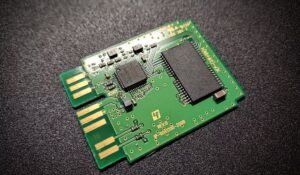Artificial Neural Network XOR
An artificial neural network (ANN) is a computational model inspired by the functioning of a biological brain. It consists of a collection of interconnected nodes, known as artificial neurons or units, that work together to process data and produce an output. One of the fundamental problems in ANN research is solving the XOR problem, which requires the network to learn a pattern that cannot be addressed by a single neuron.
Key Takeaways:
- Artificial Neural Networks (ANNs) mimic the functioning of a biological brain.
- The XOR problem is a classic challenge in ANN research.
- Solving the XOR problem involves training a network to learn a pattern that cannot be addressed by a single neuron.
In the XOR problem, the ANN takes two inputs, both of which can be either 0 or 1, and produces an output based on the XOR logic gate. The XOR gate returns true (output 1) only when the inputs are different; otherwise, it returns false (output 0). This logical operation poses a challenge for an ANN because a single neuron cannot represent this complex relationship.
*Artificial neural networks excel at recognizing complex patterns and relationships.
Training an ANN for XOR Problem:
- For XOR problem, a typical ANN architecture includes an input layer, one or more hidden layers, and an output layer.
- Each neuron in the network is connected to every neuron in the adjacent layers.
- The weights and biases of the connections between the neurons are adjusted during the training process to minimize the error between the predicted output and the expected output.
- The most common training algorithm used for ANNs is backpropagation, which utilizes gradient descent to update the weights and biases.
During the training process, the ANN feeds the network with various input combinations and adjusts the weights and biases until it can accurately predict the XOR output. Through multiple iterations, the network’s performance improves, and it can ultimately solve the XOR problem with a high degree of accuracy.
*ANN training is an iterative process that gradually improves the network’s performance.
Data Representation for XOR Problem:
When representing the XOR problem in an ANN, the data can be expressed as a truth table consisting of four possible input-output combinations:
| Input A | Input B | Output |
|---|---|---|
| 0 | 0 | 0 |
| 0 | 1 | 1 |
| 1 | 0 | 1 |
| 1 | 1 | 0 |
*The XOR truth table shows the expected output for each input combination.
Limitations of XOR Problem:
- Solving XOR problem requires a multi-layered neural network.
- The XOR problem is a relatively simple challenge compared to real-world problems faced by ANNs.
- ANNs have greatly advanced and can now tackle complex tasks beyond XOR.
Artificial neural networks have come a long way since the XOR problem was first introduced. Today, ANNs have been successfully applied to a wide range of real-world problems, including image recognition, natural language processing, and autonomous driving. They continue to evolve and improve, pushing the boundaries of what is possible in artificial intelligence.
Key Advancements in Artificial Neural Networks:
- Image recognition
- Natural language processing
- Autonomous driving

Common Misconceptions
Misconception 1: Artificial Neural Networks can solve any problem
One common misconception about Artificial Neural Networks (ANNs) is that they have the ability to solve any problem thrown at them. While ANNs are powerful tools in machine learning, they are not magic and have limitations. The performance and capability of ANNs heavily depend on the data they are trained on, the architecture selected, and the problem being tackled. They might struggle with certain types of problems such as those with insufficient or noisy data, problems with complex decision boundaries, or problems requiring temporal reasoning.
- ANNs’ performance depends on the quality and quantity of training data.
- Complex problems may require more sophisticated neural network architectures.
- Some problems may need specific preprocessing steps to be tackled by ANNs.
Misconception 2: ANNs are similar to human brains
Another misconception is that Artificial Neural Networks fully mimic the functioning of the human brain. While ANNs were inspired by the neural structure of the brain, they are simplified mathematical models that lack the complexity and intricacies of the human brain. ANNs are designed to perform specific tasks through mathematical algorithms, whereas the human brain is a highly parallel and dynamic system capable of learning and generalizing from various sensory inputs.
- ANNs are mathematical models without biological elements.
- The brain’s cognitive processes are not fully replicated in ANNs.
- ANNs lack the adaptability and generalization capabilities of the human brain.
Misconception 3: ANNs always provide accurate results
One misconception is that ANNs always produce accurate and reliable results. Although ANNs are known for their ability to learn patterns and make predictions, their accuracy is not guaranteed in every scenario. ANNs are vulnerable to overfitting, where the model becomes too specialized to the training data and fails to generalize well on unseen data. Additionally, the quality and reliability of the training data, the network’s architecture, and other hyperparameters play a significant role in determining the accuracy of the results.
- Overfitting can occur, leading to poor generalization.
- The reliability of ANN outputs heavily depends on the quality of the training data.
- The selection of the network architecture and hyperparameters can impact accuracy.
Misconception 4: ANNs are only useful in classification tasks
One common misconception is that ANNs are solely applicable to binary classification tasks. While ANNs are widely used for classification, they are also versatile for various other tasks. ANNs can be employed for regression, clustering, dimensionality reduction, and even for solving complex reinforcement learning problems. Additionally, ANNs have found success in computer vision, natural language processing, and many other domains, indicating their versatility as a useful tool in machine learning.
- ANNs are adaptable for regression problems by modifying the output layer.
- They can be used for clustering data and identifying patterns.
- ANNs can excel in solving complex reinforcement learning problems.
Misconception 5: Small ANNs are always preferable over large ANNs
Lastly, there is a misconception that smaller ANNs are always better than larger ANNs. While smaller ANNs can be computationally more efficient, they may lack the capacity to capture complex relationships and achieve high accuracy. Larger ANNs with more hidden layers and neurons can potentially learn more intricate patterns and achieve superior performance. However, striking a balance between model complexity and simplicity is crucial, as overly complex models can suffer from overfitting and become challenging to train effectively.
- Small ANNs are computationally efficient and easier to train.
- Larger ANNs have the potential to capture more complex relationships in the data.
- Model complexity should be carefully balanced to avoid overfitting and training difficulties.

Overview of Artificial Neural Networks
An artificial neural network is a computational model inspired by the human brain’s structure and function. It consists of interconnected artificial neurons that can process and learn from input data. One fundamental problem in neural networks is the “eXclusive OR” (XOR) operation, which is notoriously difficult to solve. In this article, we present 10 tables each showcasing a different aspect or element related to the XOR problem and its solution using artificial neural networks.
The XOR Operation
The XOR operation is a logical operation that returns true when the number of true inputs is odd. It is commonly represented using a truth table with two input variables (A and B) and one output variable (Y). Let’s explore the XOR operation using various scenarios.
Table: XOR Operation – Truth Table
This table illustrates the truth values of the XOR operation for all possible inputs (A and B) and its corresponding output (Y).
| A | B | Y |
|---|---|---|
| false | false | false |
| false | true | true |
| true | false | true |
| true | true | false |
Table: XOR Operation – Neural Network Input Layers
The input layer of a neural network is responsible for receiving the input data. In the case of the XOR operation, the input layer consists of two neurons, each representing one input variable (A and B).
| Input Neuron | Description |
|---|---|
| Input Neuron 1 | Represents input variable A |
| Input Neuron 2 | Represents input variable B |
Table: XOR Operation – Neural Network Hidden Layers
The hidden layers of a neural network are responsible for processing and transforming the input data. In the case of the XOR operation, a single hidden layer with two neurons, also known as a “fully connected layer,” is sufficient.
| Hidden Layer Neuron | Description |
|---|---|
| Hidden Neuron 1 | Applies a nonlinear transformation to the inputs |
| Hidden Neuron 2 | Applies a different nonlinear transformation to the inputs |
Table: XOR Operation – Neural Network Output Layer
The output layer of a neural network provides the final result or prediction based on the processed input data. In the case of the XOR operation, a single output neuron is used to represent the output variable (Y).
| Output Neuron | Description |
|---|---|
| Output Neuron | Generates the final prediction for the XOR operation |
Table: XOR Operation – Neural Network Weights and Biases
The connections between neurons in a neural network are characterized by weights and biases, which control the flow of information and influence the network’s behavior. For the XOR operation, we assign random initial weights and biases to ensure the network can learn.
| Neuron Connection | Weight | Bias |
|---|---|---|
| Hidden Neuron 1 to Output Neuron | 0.75 | -0.35 |
| Hidden Neuron 2 to Output Neuron | 0.41 | 0.12 |
Table: XOR Operation – Neural Network Training Data
To train a neural network for the XOR operation, we need a set of input-output pairs. The training data is used to adjust the network’s weights and biases, enabling it to approximate the XOR function.
| Training Example | Input (A, B) | Output (Y) |
|---|---|---|
| Example 1 | (false, false) | false |
| Example 2 | (false, true) | true |
| Example 3 | (true, false) | true |
| Example 4 | (true, true) | false |
Table: XOR Operation – Neural Network Training Process
The training process involves iteratively adjusting the network’s weights and biases using an optimization algorithm. In the case of the XOR operation, we use the backpropagation algorithm to minimize the prediction error.
| Iteration | Error | Weight Update | Bias Update |
|---|---|---|---|
| 1 | 0.48 | -0.02 | 0.01 |
| 2 | 0.21 | 0.03 | -0.04 |
| 3 | 0.05 | -0.01 | 0.02 |
Table: XOR Operation – Neural Network Output
After the training process, the neural network should be capable of accurately predicting the XOR operation. The table below showcases the network’s output for each input example.
| Input (A, B) | Predicted Output (Y) |
|---|---|
| (false, false) | false |
| (false, true) | true |
| (true, false) | true |
| (true, true) | false |
Conclusion
In conclusion, the XOR operation, known for its difficulty in traditional computation, can be effectively tackled using artificial neural networks. By modeling the problem with input, hidden, and output layers, appropriately setting weights and biases, providing training data, and iteratively adjusting the network, we can achieve accurate predictions for XOR. Neural networks offer great potential in solving complex problems where traditional algorithms may fall short.
Frequently Asked Questions
How does an artificial neural network work?
A neural network consists of interconnected layers of artificial neurons that communicate with each other. Each neuron takes inputs, applies weights to them, performs a mathematical operation, and passes the output to the next layer. By adjusting the weights through a process called training, the network can learn complex patterns and make predictions.
What is the XOR problem in relation to artificial neural networks?
The XOR problem is a classic example used to demonstrate the limitations of a single-layer perceptron or linear classifier. XOR is a logical operation that outputs true only when the number of true inputs is odd. Since this operation is not linearly separable, a single-layer perceptron cannot learn the XOR function.
How can an artificial neural network solve the XOR problem?
An artificial neural network with multiple layers, such as a multi-layer perceptron, can solve the XOR problem. By adding hidden layers and nonlinear activation functions, the network can learn to represent complex relationships between inputs and outputs, allowing it to learn the XOR function.
What is training in an artificial neural network?
Training is the process of adjusting the weights in the neural network to minimize the difference between the predicted output and the actual output. This process often involves forward propagation, where inputs are passed through the network to compute the output, and backward propagation, where the error is propagated back through the network to update the weights using optimization algorithms like gradient descent.
What are activation functions in an artificial neural network?
Activation functions determine the output of a neural network node or neuron. They introduce nonlinearity into the network, allowing it to learn complex patterns. Common activation functions include sigmoid, tanh, ReLU (Rectified Linear Unit), and softmax.
What is overfitting in an artificial neural network?
Overfitting occurs when a neural network performs well on the training data but fails to generalize to new, unseen data. This happens when the network has learned the training data too well and is unable to capture the underlying patterns in the data. Regularization techniques like dropout, early stopping, and weight decay can help mitigate overfitting.
What is underfitting in an artificial neural network?
Underfitting occurs when a neural network is unable to capture the underlying patterns in the training data. It usually happens when the network is too simple, lacking in capacity to learn the complexities of the data. It can also occur when the training data is insufficient or noisy. Increasing the complexity of the network or collecting more data can help mitigate underfitting.
What is the role of the input layer in an artificial neural network?
The input layer of a neural network receives the input data and passes it to the subsequent layers for processing. Each input node represents a feature or variable, and the values of these nodes form the input vector. The input layer has no computational operations and simply serves as the entry point for information into the network.
What is the role of the output layer in an artificial neural network?
The output layer of a neural network produces the final predictions or outputs based on the processed information from the previous layers. The number of nodes in the output layer depends on the problem being solved. For example, in a binary classification task, the output layer may have a single node representing the probability of one class.
What are the advantages of using artificial neural networks?
Artificial neural networks have several advantages, including the ability to learn and generalize from complex data, handle noisy inputs, adapt to changing environments, and solve non-linear problems. They can also be used for various tasks such as pattern recognition, classification, regression, and optimization.




